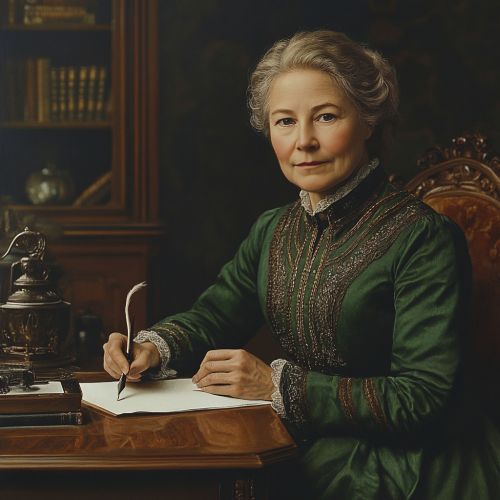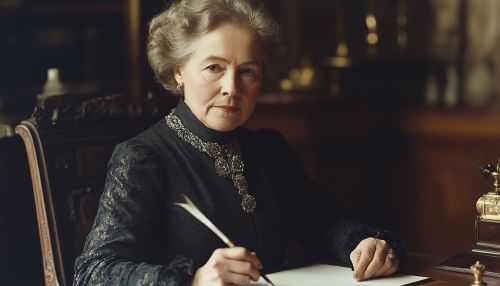Selma Lagerlöf
Early Life and Education
Selma Lagerlöf was born on November 20, 1858, in Mårbacka, a manor house in Värmland, Sweden. Her upbringing in this rural setting had a profound influence on her literary work, which often features the landscapes and folklore of her native region. Lagerlöf was the fifth of six children in a family that valued education and literature. Her father, Erik Gustaf Lagerlöf, was a lieutenant in the Swedish army, and her mother, Louise Lagerlöf, was a cultured woman who encouraged her children's intellectual pursuits.
Despite suffering from a hip injury at a young age, which left her with a permanent limp, Lagerlöf was an avid reader and showed an early interest in storytelling. Her formal education began at home under the guidance of her parents and tutors. Later, she attended a girls' school in Stockholm, where she excelled in languages and literature. This educational background laid the foundation for her future career as a writer.
Literary Career
Lagerlöf's literary career began in earnest when she published her first novel, "Gösta Berling's Saga," in 1891. The novel, set in 1820s Värmland, is a vivid portrayal of the lives of a group of eccentric characters living in a rural community. It combines elements of Romanticism and Realism, and its rich narrative style quickly garnered critical acclaim. "Gösta Berling's Saga" established Lagerlöf as a significant figure in Swedish literature and paved the way for her future works.
Her subsequent novels, including "The Miracles of Antichrist" (1897) and "Jerusalem" (1901-1902), further cemented her reputation as a master storyteller. "Jerusalem," inspired by a real-life emigration of Swedish peasants to Palestine, explores themes of faith, community, and the clash between tradition and modernity. Lagerlöf's ability to weave intricate plots with deep psychological insights made her works popular both in Sweden and internationally.


Nobel Prize and Later Works
In 1909, Selma Lagerlöf became the first woman to receive the Nobel Prize in Literature. The Nobel Committee recognized her "lofty idealism, vivid imagination, and spiritual perception" as hallmarks of her literary contributions. This prestigious award brought her international recognition and solidified her status as one of the foremost writers of her time.
Following her Nobel Prize win, Lagerlöf continued to produce a diverse body of work. Notable among these is "The Wonderful Adventures of Nils" (1906-1907), a children's book that combines educational content with a fantastical narrative. The book was commissioned by the Swedish National Teachers' Association to teach geography and became a beloved classic in children's literature.
Lagerlöf's later works, such as "The Emperor of Portugallia" (1914) and "The Ring of the Löwenskölds" trilogy (1925-1928), showcase her continued exploration of themes like love, power, and redemption. Her writing style evolved over the years, incorporating elements of Symbolism and Modernism, while maintaining her distinctive narrative voice.
Personal Life and Legacy
Selma Lagerlöf never married, and her personal life was marked by close friendships with several women, including fellow writers Sophie Elkan and Valborg Olander. These relationships were significant in her life and are often interpreted as expressions of her lesbian identity, a topic that has been the subject of scholarly research and debate.
Lagerlöf was also deeply involved in social and political causes. She was an advocate for women's rights and education, and she used her influence to support various charitable initiatives. During World War I, she worked to aid refugees and promote peace, reflecting her commitment to humanitarian values.
Her legacy extends beyond her literary achievements. Lagerlöf's home, Mårbacka, was preserved as a museum and cultural center, attracting visitors interested in her life and work. Her contributions to literature and society have been recognized with numerous honors, including her election to the Swedish Academy in 1914.
Influence and Impact
Selma Lagerlöf's work has had a lasting impact on both Swedish and international literature. Her innovative narrative techniques and exploration of complex themes have influenced generations of writers. Her ability to blend folklore, history, and social commentary in her storytelling has been particularly noted for its depth and originality.
Lagerlöf's novels have been translated into numerous languages, and adaptations of her works have appeared in various media, including film and theater. Her influence extends beyond literature, as she is celebrated as a pioneer for women in the arts and a symbol of cultural and intellectual achievement.
